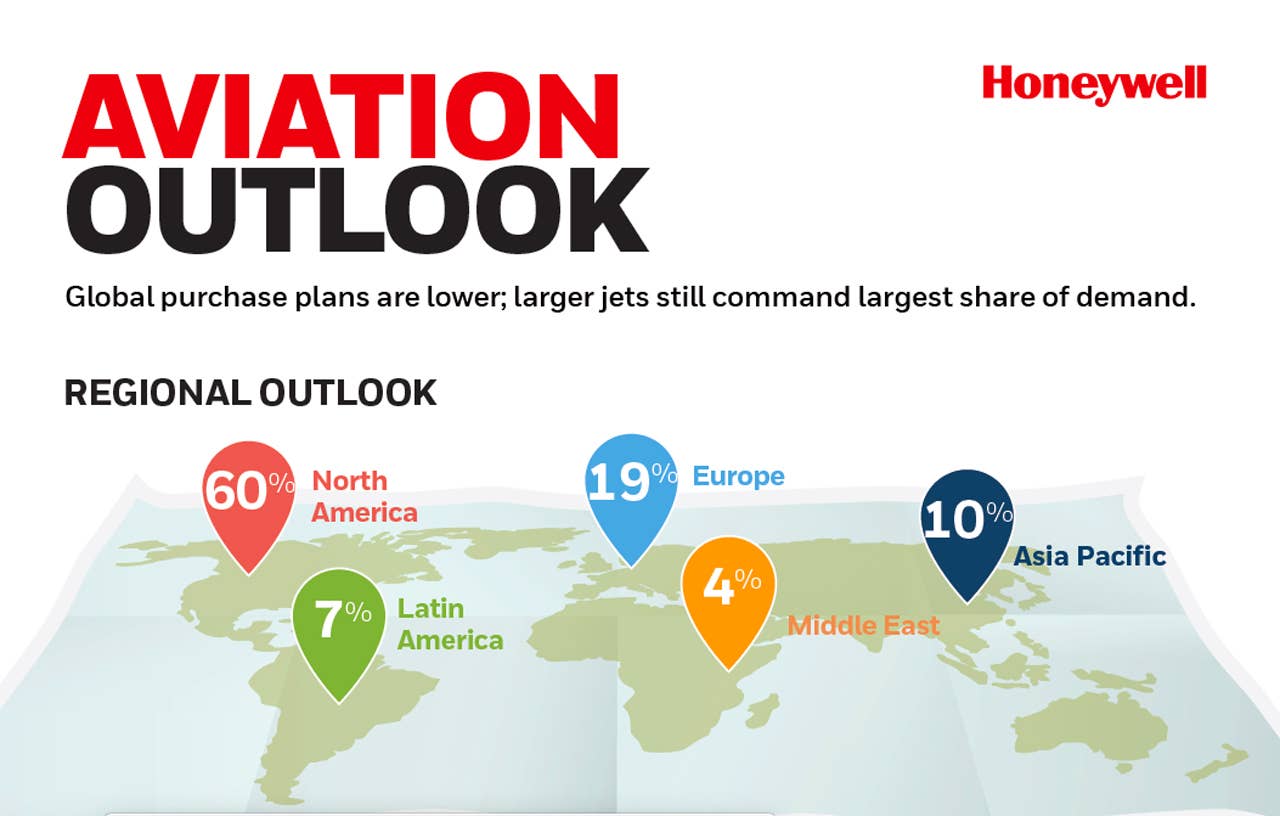
The Honeywell Aviation Outlook looks ahead ten years using interviews with current operators. Honeywell
Honeywell released its 2019 Global Business Aviation Outlook on Sunday, October 20, at the opening of the NBAA-BACE conference in Las Vegas, Nevada. The report shows 7,600 new deliveries of business jets for the period 2020 to 2029, with a total value of $248 billion. The total dollar amount reflects a drop of 1% over last year's report. Flying spoke with Gaetan Handfield, senior manager of marketing analysis for Honeywell, before the show regarding the forecast and its implications for the next ten years.
The company predicts that an estimated 60% of demand will come from North America, still the leader in this market—with 65% of the current turbine fleet, according to Handfield. The breakdown of the rest of the world? Europe has 19% of demand, 10% in Asia Pacific, 7% in Latin America, and 4% in the Middle East and Africa.
Overall, timing of planned purchases was higher in terms of short-term deals than last year, somewhat balancing the overall reduction in the rate, with 35% globally planning a purchase in the next two years—up from 30% last year. In Latin America, only 29% spoke of plans for a short-term purchase, thus demonstrating “more caution,” according to Hartfield. Asia Pacific showed the highest amount of short-term fever, with 40% indicating the plan to buy in the two-year timeframe. It may very well be that the number demonstrates that a company will see a new aircraft delivery already on the books for that time period, according to Handfield, which would explain the relatively elevated number in the region.
A significant 42% of the planned total airframes is for large-cabin jets (those priced at more than $30 million), with 29% going to midsized and another 29% planned for jets on the lower end. The top end represents 71% of the total dollars allocated. Utilization also features in the report, with activity “stable everywhere but lower in Europe,” Handfield said.
One “surprise” in the report: Used aircraft make up 32% of the fleet replacements predicted. North America is up 11% in terms of intention to buy used, with 50% of those intended purchases indicating aircraft that have aged 5 years or less—to include aircraft that haven’t delivered yet. There’s a high expectation to find a relatively young used aircraft—and an operator might have to transition to a truly new aircraft or an older used aircraft if those desirable new-ish tails aren’t available. “[There may be] more caution about saying ‘I’m buying a new plane, so I’ll say I’m buying a used aircraft,’” said Handfield. Operators are still hoping they’re going to get great deals on the used market—but some of those don’t make any sense, as they indicate aircraft that are hard (or impossible) to find, such as the Falcon 6X.
Over the three months Honeywell spends conducting the survey, operators interviewed reported that 17% of their existing fleets had been replaced or expanded with new aircraft, which is 3% lower than last year (20%). While North America and Latin America remain steady, at 15% and 22% respectively, Europe showed a significant softening (from 33% last year to 25% this year). Asia Pacific increased from 12% to 15%.
The survey polled more than 1,500 business jet operators globally, a number not including fractional operators. Honeywell considers the sample representative of the entire industry in terms of geography, operation, and fleet composition. “When we asked a respondent if they have something ordered but not delivered,” said Handfield, that indicates in part the presence of backlogs starting to release at Cessna (with the Longitude) and Gulfstream (with the G600/G500).
The global economy plays a large part of course—for example, in Europe. “When I look at Europe,” said Handfield, “I see it stable in the UK compared to last year. It’s really Germany, which is in recession, and France driving [that slowdown].”

Subscribe to Our Newsletter
Get the latest FLYING stories delivered directly to your inbox






